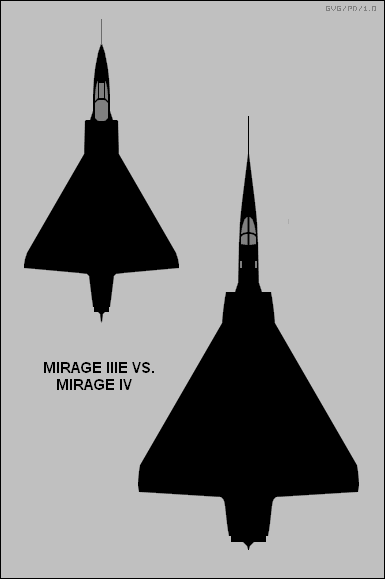The Dassault Mirage IV
v1.0.1 / 01 may 02 / greg goebel / public domain
* In the mid-1950s, the French decided to develop a nuclear deterrent force, which led to a need for a strategic bomber. As a interim measure, they simply built a scaled-up version of the Mirage III fighter, known as the "Mirage IV", with the expectation that it would be soon replaced by a more capable aircraft.
It is said that there is nothing so permanent as a temporary solution, and the Mirage IV was still flying in combat at the end of the century, if admittedly in small numbers and as a spy plane, not a bomber. This document provides a short history of the Mirage IV.

[1] MIRAGE IV BOMBER
[2] MIRAGE IVR RECONNAISSANCE VARIANT
[3] COMMENTS, SOURCES, & REVISION HISTORY
[1] MIRAGE IV BOMBER
* The decision to acquire a nuclear strike capability would lead the French to eventually develop land-based and submarine-based missiles, and a strategic bomber, the Mirage IV, with work on the aircraft begun in 1957. Dassault met the French government requirement for a strategic bomber by scaling up the Mirage III 50% in linear dimensions, doubling weight and wing area.
The prototype Mirage IV first flew in June 1959, and was fitted with twin Atar 09C engines. The second prototype flew in October 1961, after the French had detonated their first nuclear weapon in February 1960, and was closer to production spec, with a shorter vertical tailplane. There were two more prototypes, the last of which used the production-spec Atar 09K engine, with 4,700 kilograms (10,400 pounds) dry thrust and 6,700 kilograms (14,800 pounds) afterburning thrust.
A total of 62 Mirage IVs were built between December 1963 and November 1966. Except for the twin engines, the general configuration of the aircraft strongly resembled that of the Mirage III. Less noticeable differences were the tandem cockpit for pilot and navigator, and main gear bogeys with four tires each. The nose gear had two tires.

The Mirage IV's wing had the 60 degree sweep of the Mirage III, but featured
a thinner chord of 3.8% at the root. This relatively thinner wing was
permitted by the aircraft's greater size and was better suited for supersonic
flight. The wing contained fuel tanks, as did the tailfin. Since delta
wings demand a lot of runway to for takeoff, a loaded Mirage IV was fitted
with rocket-assisted take-off (RATO) boosters, four attached at the rear of
each wing. The RATO boosters were discarded after take-off.
DASSAULT MIRAGE IV:
_____________________ _________________ _______________________
spec metric english
_____________________ _________________ _______________________
wingspan 11.85 meters 38 feet 10.5 inches
length 23.50 meters 77 feet 1.2 inches
height 5.65 meters 18 feet 6.4 inches
empty weight 14,500 kilograms 32,000 pounds
max loaded weight 31,600 kilograms 70,000 pounds
maximum speed 2,335 KPH 1,450 MPH / 1,260 KT
service ceiling 20,000 meters 65,600 feet
range 3,200 kilometers 2,000 MI / 1,740 NMI
_____________________ _________________ _______________________
There was a circular radome on the belly of the aircraft, just behind the air intakes. There were two stores pylons on each wing, with the inner one normally used for a drop tank and the outer one used for a flare dispenser or other countermeasures gear. The weapon for which the Mirage IV was designed, the 60 kilotonne "AN-22" nuclear weapon, fit into a recess in the fuselage. This weapon was modified after late 1967 to be parachute-retarded, when it was realized that the Mirage IV could not expect to penetrate Soviet airspace at high altitude.
The Mirage IV obtained a new lease on life in the bomber role when 18 were rebuilt as "Mirage IVPs", where "P" for "Penetration", to carry the ASMP ramjet-powered stand-off missile, instead of the AN-22 bomb. This meant a considerable upgrade of the aircraft's avionics and the addition of a center pylon for carriage of the ASMP.
[2] MIRAGE IVR RECONNAISSANCE VARIANT
* In the late 1970s, twelve Mirage IVAs were relegated to the strategic reconnaissance mission by replacing the AN-22 bomb with the CT-52 sensor pod, providing a capability along the lines of a "poor man's SR-71". The sensor pod accommodated three low-level and three high-altitude cameras, plus a mapping camera or infrared linescan sensor. The reconnaissance variant was designated "Mirage IVR".
By the end of the century, all Mirage IV bombers had been retired, with the Mirage 2000 serving as the carrier for the ASMP missile. However, five Mirage IVRs were still in service, and three of these made significant contributions to the NATO air campaign against Yugoslavia in the spring of 1999. These machines performed high altitude, high speed overflights of Yugoslavian territory, observing about 20 targets on a mission.
While the CT-52 pod's cameras were all "wet film" instruments, the film was quickly developed, annotated, digitized, and electronically distributed after return to base, providing NATO commanders with up-to-date imagery intelligence.
[3] COMMENTS, SOURCES, & REVISION HISTORY
* Judging the success of the Mirage IV is difficult, particularly since it has seen little active combat service. The aircraft was clearly a compromise type with many limitations, but it did fulfill its assigned mission, and served for long after it was to have been phased out.
One judgement is less ambiguous. The Mirage IV was a sleek and elegant machine and pictures of it taking off with its roaring RATO boosters imply that it was impressive to watch as it climbed off into the sky.
* Sources include:
- THE WORLD'S GREAT ATTACK AIRCRAFT, Aerospace Publishing, 1988.
Various recent operational details for the Mirage IV were obtained from my archive of WORLD AIR POWER JOURNAL magazines.
* Revision history:
v1.0 / 01 apr 00 / gvg
v1.0.1 / 01 may 02 / gvg / Minor cosmetic update.